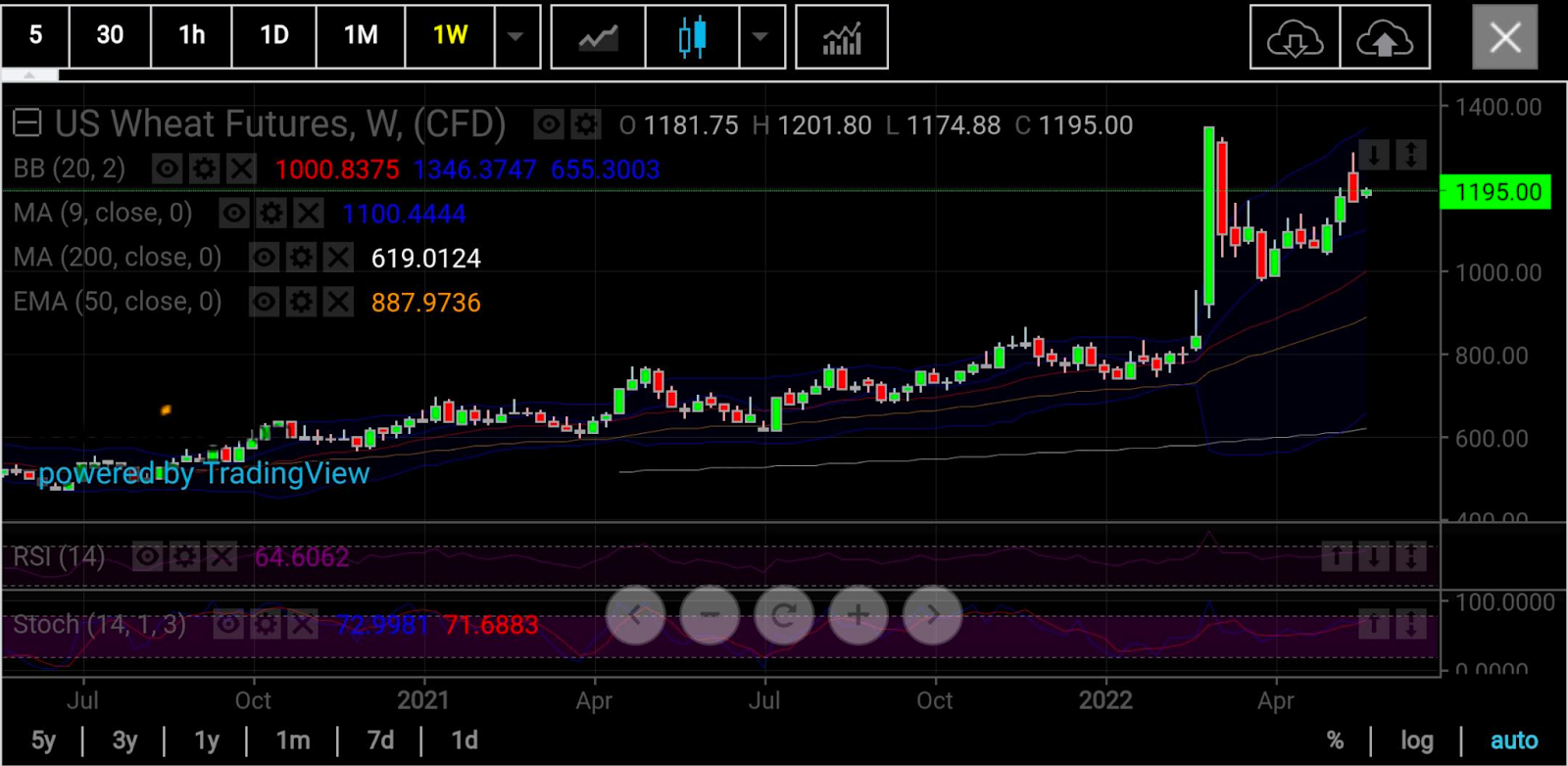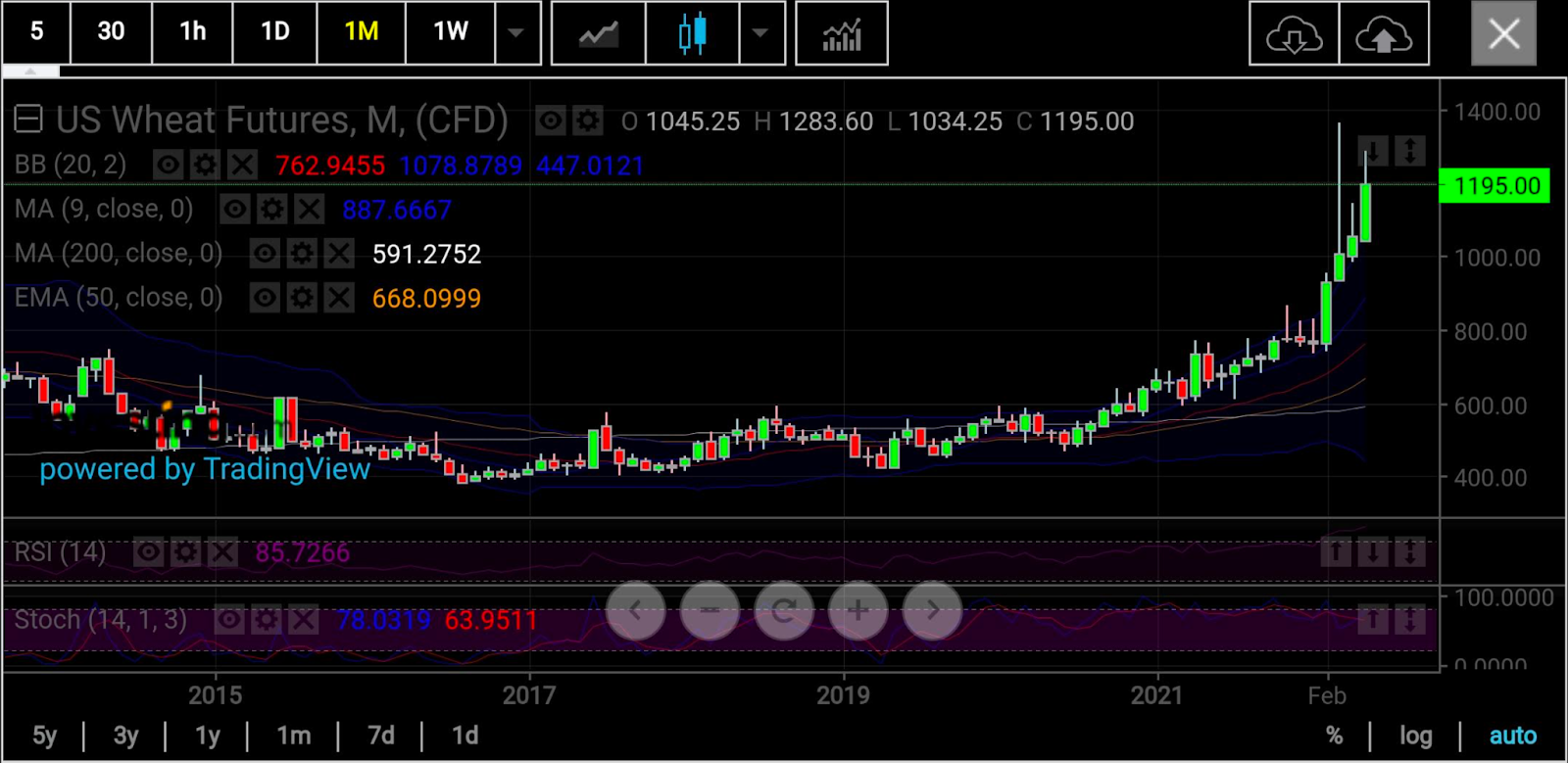Ten days after India shocked the world by banning wheat shipments from the second largest producer, the grain’s prices have softened a little but not enough to weaken their upward trajectory.
Wheat charts are still glowing, emitting red-hot signals of record highs of between $13 and $14 a bushel to come on the Chicago Board of Trade—despite their cooling to below the $12 peaks reached right after news of the India ban.

The technical picture reinforces the fundamental story behind wheat. On May 16, just two days after the ban announced by New Delhi, the US Department of Agriculture (USDA) projected the 2022/23 season-average farm price for wheat at a record $10.75 per bushel, supported by what it called tight domestic stocks.
While the farm price is a different measure to the futures in Chicago, it reflects elevated cash and futures rates for wheat and uncertainty in global markets that signal even strong pricing ahead.
The USDA pegged world wheat ending stocks for the 2022-23 marketing year at 267 million tonnes, a six-year low, well below analyst estimates of 272 million.
“Despite global wheat prices trading at record highs for the time of year, market participants may have been too optimistic on the supply outlook for the upcoming year if the U.S. government’s new projections are any indication,” Reuters grains analyst Karen Braun said in a May 13 post.
“But relative to estimated global demand, wheat supplies for the upcoming cycle are seen dangerously close to all-time lows and notably below this year’s reduced levels,” she added.
Braun noted that excluding China, world wheat stocks-to-use for 2022-23 were projected to fall to 14.9% from 16.4% this year, making it the fourth lowest ever. The record of 14.3% was set in 2007-08, and the average from the mid-last decade was 19%.

The USDA itself says that for 2022/23, a slightly larger production was projected compared to the previous year. Still, the output would be the second lowest in the last 20 years based on pervasive drought in major hard red winter wheat growing areas. Even with domestic use and exports projected down from the previous year, ending stocks are forecast to decline once again.
“That could keep wheat prices elevated into 2023, impacting food prices for consumers globally and ensuring continued high costs for importer countries,” Braun said, adding that further risks to 2022-23 wheat supplies were possible.
US wheat futures already hit record highs of $13.40 a bushel on Mar. 4, after the Feb. 24 invasion of Ukraine by Russia upended the global market for the grain. Prior to that, Russia and Ukraine used to jointly supply nearly 30% of the world's wheat from vast and fertile farmlands in the Black Sea region known as the “breadbasket of the world.”
Despite the supply deficit, Chicago wheat fell below $10 a bushel by Apr. 4—exactly a month after its record high—on signs of some relief in shipments from the Black Sea despite the Ukraine war.
India’s ban, announced on Friday, put the market on a different trajectory. The embargo was announced as heatwaves decimated the wheat crop in the world’s second largest grower, which produced 107.59 million tonnes in 2020. That’s individually more than the 85.9 million tonnes produced by Russia and the 24.9 million produced by Ukraine that year, although the two “breadbasket” nations cumulatively commanded 110.8 million tonnes of world supply, versus the 134.25 million from top grower China.
India targeted to export a record 10 million tons of wheat in 2022-23 after importing nations looked to New Delhi to fill in the gap following Russia's war on Ukraine. But as record-shattering heatwaves sent temperatures above 50°C (122°F), damaging wheat yields across India, the government was forced to reconsider its position.
India’s Directorate General of Foreign Trade, however, made a concession—that exports would still be allowed for countries that require wheat for food security. All other new shipments would be banned, it said.
Even so, the ban puts additional strain on the world export market for wheat, considering that India was expected to be an alternative to Russia and Ukraine amid the ongoing war.

In Tuesday’s session, soft red winter wheat futures on the Chicago Board of Trade hovered at $11.93 per bushel, versus the $12.84 peak reached on May 17 after the announcement of the India export ban.
Year-to-date, Chicago wheat is up 55%, turning everything made from the produce, including bread, cakes, and noodles, costlier as US inflation itself runs at 40-year highs.
Charts indicate that Chicago wheat could set new peaks of between $13 and $14 when the current consolidation ends, said Sunil Kumar Dixit, chief technical strategist at skcharting.com.
“The upside momentum has been tested at $12.84 and it paused,” said Dixit.
“The price action now indicates a consolidation is taking place at between $12 and $11,” he said, adding that the stochastic and Relative Strength Index parameters were neutral on wheat’s daily charts and strong on the weekly charts.
If Chicago wheat futures continue hanging below $12, they can plumb support levels of $11 to $11.30, Dixit said, adding that a break below there could even push the market toward $10 levels.
“But since the underlying trend is bullish, buyers are likely to come in once prices test those support areas,” said Dixit.
“The wheat rally can then resume, revisiting $12.80 and making a consistent break above $13 to $13.50.”
Disclaimer: Barani Krishnan uses a range of views outside his own to bring diversity to his analysis of any market. For neutrality, he sometimes presents contrarian views and market variables. He does not hold a position in the commodities and securities he writes about.
